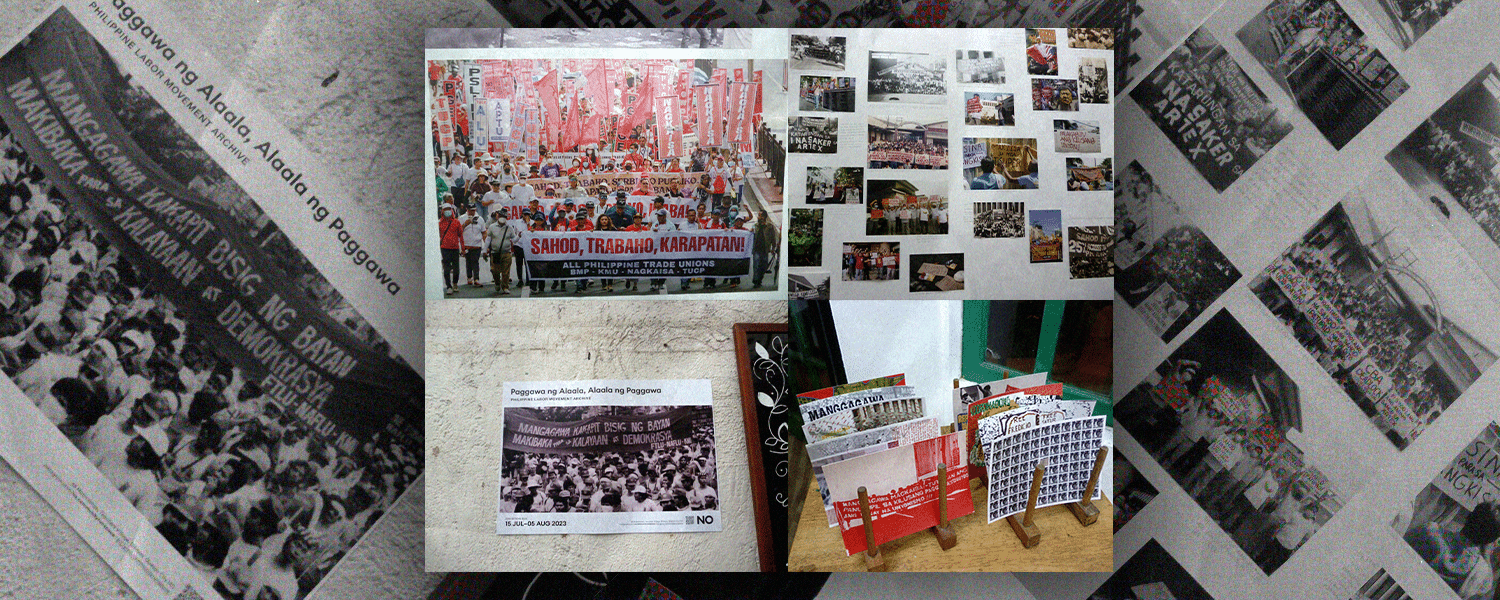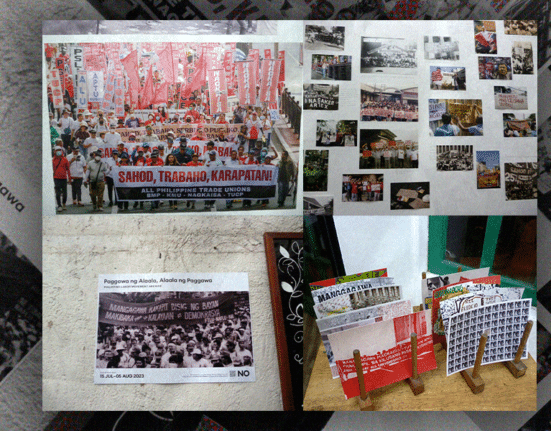THE Philippine Labor Movement Archive (PLMA) has launched its newest exhibition, Paggawa ng Alaala, Alaala ng Paggawa, which seeks to educate people about what transpired during Martial Law.
The exhibit, launched July 15, is a joint initiative of the Mayday Multimedia, Kilusang Mayo Uno, Balai Obrero Foundation, Tambisan sa Sining, and the Ecumenical Institute for Labor Education and Research, and was made possible with help from the National Commission for Culture and the Arts.
23-year-old multimedia artist Kim Gonzales, who worked closely with the PLMA to make this project possible, explained that the organization was initially created to preserve and promote the historical struggle of the Filipino working class to bring light to issues such as just proper wages, decent work, as well as trade union and human rights.
“[It] was conceived in a time when another Marcos was in the presidential seat, a time when disinformation was rampant,” Gonzales said. “It is envisioned to be a community archive of workers’ historical narratives of political and economic struggles.”
Gonzales said this exhibit aims to show the parallels between the current administration of Ferdinand Marcos Jr. and that of his father, the late dictator Ferdinand Marcos Sr.
It also showcases a number of photographs that gives a glimpse into the lives of everyday Filipino workers and people who were alive during Martial Law.
These are accompanied by written materials that help to shed light on the issues during Martial Law and during the current Marcos presidency.
Several pieces from contemporary artists Ryan Alcarde, Josh Paradeza, Eric Bico, Joyce Cabat, Christine Chung, Kum Gonzales, Kate Calimag, Laurie Maravilla, Chat Palmos, Kallista Rivera, and Iggy Sandrino are also featured at the exhibit.
These artists have also turned some photos taken during Martial Law into postcard designs.
“Both this exhibition and the PLMA in general serve to register in the collective memory of the Filipino people the victories achieved through the unity of the working class, the important role that they have played and continue to play in leading the struggle for democratic rights,” the PLMA wrote in its Facebook post announcing the exhibit.
“The masses truly are the makers of history,” it added.
Initial thoughts on Marcos presidency
republicasia asked viewers of the exhibit for their thoughts on current and former Marcos presidencies.
For 27-year-old multimedia artist Chi Pepito, the incumbent Marocs administration appears to be a photocopy of his father’s.
“Ang batayan natin ng kagalingan ng isang lider ay kung paano niya naiaangat yung masa; halimbawa, kung isa kang presidente, paano mo napagaan yung buhay ng mga masang Filipino?” said Pepito.
University of the Philippines Los Baños student Ileana Acervo, 22, noted that the issues that were present during the first Marcos administration have continued to hound the country through the years, regardless of who was sitting as President.
Mari Ugoy, a 29-year-old member of the alliance SAKA PH,, said that while there are many things that the current President has done, there is nothing that she would consider to be positive.
“Marami siyang pinangako na hindi naman napatupad,” she said.
One of the examples that she cited was the president’s promise to bring the price of rice down to P20 per kilo, which is still not the case as rice is being sold at P43 per kilo.
As for the exhibit, Ugoy said: “Malaki yung similarities ng dalawang mag-ama. Halatang pinapatuloy lang ni BBM ang legasiya ng tatay niya.”
The first look
When Ugoy first laid eyes on the photos within the exhibit, she said she felt a chill run down her spine, hair standing on edge as she read through the different passages and absorbed the furrowed brows and open mouths of those in the photos shouting for their rights to be acknowledged.
“Makikita mo yung pagkikilos ng manggagawa noon hanggang ngayon, at patuloy-tuloy lang yung pagkilos nila; palakas [lang] nang palakas yung pagkilos ng mga manggagawa,” she said.
One thing that stood out to Pepito when she first viewed the exhibit was the fact that many of the demands being made by the people in the photos – as seen in the signs held up in them – continue to mirror the demands that protesters continue to make in the modern day.
“Yung mga panawagan ng mga manggagawa at ng mga batayang sektor ay hindi naman nagbago. Dine-demand pa rin nila yung pagbabaga ng presyo ng langis [at] ng mga bilihin, at pagtaaas ng sahod,” said Pepito.
She said she applauds the efforts of this exhibit because she, like many Filipinos today, wasn’t alive yet during the Martial Law of Marcos Sr.
Acervo pointed out the beauty of putting the photos of the people today beside those of the past.
“Yung isang na-appreciate ko din about sa finefeature na images, yung hanay ng mga manggagawa na nagle-lead sa movement, and yung then and now,” she said. “Mass testament din siya historically kung papano sila consistent and steadfast with advocating for everything.”
The archiving and presenting of these photos to the public is intended to help people visualize what truly happened Martial Law, proving that the stories of their elders are more than just myths or figments of the imagination.
They’re real – flesh and blood, caught on camera.
“Kitang kita natin sa mga larawan na ‘to na grabe yung paghihirap ng masang Pilipino, lalo nung panahon ng Martial Law; wala man tayong Martial Law ngayon, [pero] nararamdaman pa rin natin yung paghihirap nila noon,” Pepito said.
Relevance today
Many have noticed a growing pattern of historical revisionism happening within the Philippines.
Cesar Ramirez, a writer for The McGill International Review, notes that one example of this is that the atrocities that occurred during Martial Law are seemingly being brushed under the rug as the achievements of the administration during that time are being highlighted instead. There are even those romanticizing this period in history instead of showing to the people how it really was at the time.
It has been reported that numerous members of the youth already have several misconceptions about what truly happened during the time of Martial Law in the country.
Some students have started to spew out false narratives – narratives that have come from the mouths of the very academic institutions meant to teach them the truth. This is why more than ever, exhibits like this matter.
Erickvae Ricafort, a 22-year-old 3rd-year student at the University of the East Caloocan and member of the group Rise for Education, said the preservation of the photos from the Martial Law era prove that what the masses have been fighting for all these years amounts to more than just matters of hearsay.
“Hindi lang siya basta rally,” Ricafort said.
These images show that there were real people who sacrificed their lives so people in the present – the youth, especially – may be able to live as freely as they do now.
“Importante talaga na may ganitong mga klaseng exhibit, kasi form siya ng education [sa] kung ano yung struggle ng manggagawa, ng masa. Maganda yung ganito kasi may iba’t ibang platform ng pag-educate,” Ugoy said.
Pepito also said that it is through this manner of saving and archiving photos like these that help to ensure that a part of Philippine history will never be forgotten. As small an action others may see it, it is still a way for people to fight back against the historical revisionism rampant in the country today.
Ricafort said it is also a way of preserving the truth.
“Madali na kumalat yung fake news ngayon. Sinasabi [nila] na ‘di totoo yung mga nangyari, yung mga reklamo ng mga tao. Ito yung mga nangyayari na pilit nilang binabasura, pilit nilang kinakalimutan,” she said.
Only until August 5
The exhibit is available for viewing at NO Community-run Space and can be visited untilAugust 5, 2023. It’s located at 45 Matimtiman Street, Teacher’s Village, Diliman, Quezon City, and is open from 6 PM until 9 PM.
The PLMA described this exhibit to be an active form of resistance, which is especially needed in a time wherein the truth constantly seems to be either maligned, opposed, or even neglected altogether.
Postcards of photos from the PLMA’s archive, altered by several talented contemporary artists, are available for sale for P150 each at the event. The money earned from this will then be given to the NO Community-run Space, the PLMA, and the artists that helped in bringing the pieces to life.
The PLMA also accepts volunteers, looking for anyone willing to preserve and archive the important materials about the Filipino worker’s struggle, according to Gonzales.
“It is time to combat the reigning historical revisionism and disinformation by recognizing the role and potential of workers in creating history and changing the whole political landscape,” she stated.









